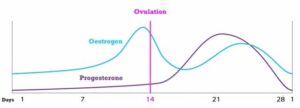Why is Hormone Balance So Important for Your Health?

Hormones are proteins produced by endocrine glands, the many glands in our body which constitute the Endocrine System. A woman’s ovaries are endocrine glands that produce female hormones that regulate a woman’s menstrual cycles, fertility, reproduction and also menopause. The ovaries are considered organs of both the endocrine and reproductive systems.
For women to stay healthy, energetic and youthful, two main hormones require balance – estrogen and progesterone. Estrogen levels rise when a girl is around 10 to 12 years of age, marking the start of puberty. They are responsible for changes that occur in her body during puberty, the most obvious being breast and uterine development and female body shape, among others. Once her ovarian clock begins cycling during puberty, ovulation begins around day 14 of her twenty-eight day cycle, once per month, triggering the production of another hormone called progesterone. Progesterone regulates her once per month menstrual cycle and also her ability to maintain a pregnancy if the egg is fertilized. Progesterone also supports her bones, joints, ligaments, tendons, nervous system, hair growth, memory, thyroid function, mood, vascular system and sleep cycle.
Let me briefly explain how a woman’s reproductive system is regulated by estrogen and progesterone. The pituitary gland, also called the “Master Gland,” is located on the undersurface of the brain. It is considered the ‘symphony conductor’ of endocrine organs in both men and women, and produces specific stimulating hormones that trigger specific endocrine organs to produce the hormones they are responsible for. For the purpose of this article, I will only focus on the regulation of ovaries, the endocrine organs of the reproductive system in a woman.
The pituitary gland secretes a stimulating hormone called Follicle Stimulating Hormone or FSH which triggers estrogen production by the ovaries, located one on each side of the uterus. The ovaries contain hundreds of eggs. One egg is programmed to grow every month under the influence of estrogen in a woman’s body after puberty till she reaches her mid to late forties. This egg grows for about 14 days, then the pituitary secretes Luteinizing Hormone or LH which triggers the egg to leave the ovary and begin traveling down the fallopian tube on its way to the uterus. Once this occurs, the membranous sac where the egg popped out of called the corpus luteum, begins to produce progesterone.
Estrogen is required for a woman’s body to thicken the inner lining of the uterus in preparation for a potential pregnancy. It takes about 14 days to create this. Then she ovulates, releasing an egg out of the ovary (ovulation), ready to be fertilized by a sperm before it implants in the prepared uterine lining. Progesterone’s role is to maintain this lining and prevent it from shedding, in case a pregnancy does occur. This is nature’s way of preserving a pregnancy and preventing miscarriage. Progesterone levels must be high enough to do this job, in other words, they must be high enough to balance estrogen in a precise ratio (figure 1).
When progesterone levels are too low due to stress, obesity, a poor diet, alcohol use or presence of a significant amount of hormone disruptors, estrogen dominates the ideal estrogen to progesterone ratio and wreaks havoc in the body. A natural condition where progesterone levels are too low to balance estrogen is in a woman’s forties as she ages. On average, after the age of 35, a woman’s progesterone level begins to fall, making the gradient between estrogen and progesterone higher till estrogen levels also begin to fall, heralding menopause.

figure 1: The female menstrual cycle
A low level of progesterone relative to estrogen often results in symptoms such as: weight gain, hot flashes, night sweats, heavy bleeding during menses, thyroid dysregulation, sleep disturbance, nervous system dysfunction, memory impairment, mental fog, muscle pain, fatigue, hair loss, depression, anxiety, agitation, difficulty concentrating, and a decrease in libido.
If any of these sound familiar prior to your period, you likely have estrogen dominance also termed hormone imbalance, where your progesterone level is not high enough to balance estrogen during the latter half of your cycle.
As a woman’s menstrual cycle progresses, if an egg is not fertilized after it is released during mid-cycle as described above, progesterone levels fall abruptly on average around the 26 to 28th day of the cycle, and menses begins, thereby shedding the uterine lining the body so carefully prepared for a potential pregnancy. This is normally what causes a woman to menstruate.
The safest way to balance estrogen with progesterone in the case of estrogen dominance, is with bio-identical progesterone, that is, progesterone whose molecular structure is identical to what your body produces. This is only available through a compounding pharmacy. Regular pharmacies dispense synthetic progesterone or Progestin, which is not molecularly identical to what your body produces, so it can have many side effects, some of which are harmful to your body.
After menopause (the cessation of menstrual cycles), depending upon a woman’s symptoms, (many of which are similar to those mentioned above except heavy bleeding), the dose of prescribed hormones must be significantly lower than for menstrual and pre-menopausal women. This is essential to ensure therapeutic efficacy with minimal to no harmful effects, only achieved at lower doses. Hormone replacement therapy after menopause carries much greater risk of harmful side effects than hormone balancing does, since it consists of either synthetic hormones or bio-identical ones at much higher doses than are needed for well-being.
In addition, I have seen many women consult with me after experiencing harmful side effects of testosterone pellets, inserted underneath the skin by well-meaning physicians. This too is harmful to a woman’s body as high levels of testosterone from these pellets convert into high levels of estrogen, resulting in moderate estrogen dominance. Estrogen dominance to this degree, carries a significant risk of serious side effects such as hypertension, blood clots, heart attacks, stroke, breast cancer, weight gain, sleep disturbance, anxiety and depression. It is best to balance hormones bio-identically rather than replace them with synthetic substitutes or pellets. As many women have experienced, the latter can lead to dangerous consequences and every woman should know the difference between synthetic and bio-identical hormones and hormone balance versus hormone replacement therapy.
Many physicians may prescribe bio-identical hormones in very high doses. This degree of dosing overrides the safety that bio-identical hormones offer and is dangerous for women to receive after menopause. This is why balancing hormones is much safer than replacing them.
It is important for any woman who is being treated with bio-identical hormones to have regular blood hormone levels checked to adjust the doses of hormones being taken. Checking blood levels periodically is critical to ensure evidence-based safety. The popular saliva test does not provide the accuracy for dose adjusting that blood levels do, and the results can be notoriously inaccurate making it difficult to find a stable dosing regimen.
As you can surmise, hormone balancing requires not only scientific expertise but is also an art, important to be customized for every woman individually, after assessing both her clinical response and blood levels to ensure safety and therapeutic efficacy.
It is important to mention that both the liver and gut microbiome play a crucial role in hormone balancing. They deactivate hormones used up by the body and assist in eliminating them, to keep levels from being elevated. Alcohol (processed in the liver) interferes with estrogen metabolism causing estrogen dominance. It also disrupts the gut microbiome, effecting its health and functional abilities. When the gut flora (microbiome) is not healthy, due to alcohol, a poor diet or lack of exercise, this can increase estrogen absorption resulting in estrogen dominance. As we can see, all of our body systems work together to maintain our health, and it is important for us to supply them with a nourishing lifestyle so they can function to regulate balance and provide us with health throughout our lives.
If you or anyone you know needs hormone balance, please do not hesitate to contact The Ommani Center. Dr. Kumar has assisted tens of thousands of women achieve extraordinary health and vitality with evidence-based methods for balancing hormones.
©March2022 Kalpana (Rose) M. Kumar M.D., CEO and Medical Director, The Ommani Center for Integrative Medicine, Pewaukee, WI. www.ommanicenter.com Author of Becoming Real: Reclaiming Your Health in Midlife (2nd Edition), Medial Press, 2014. Dr. Kumar is currently accepting new patients. Call 262.695.5311 for an appointment, either virtual or in-person for those free of symptoms.
